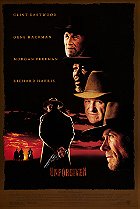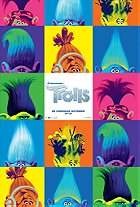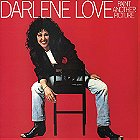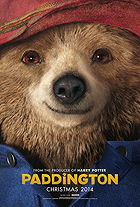Posted : 6 years, 6 months ago on 12 December 2018 08:20
(A review of
It is fitting that Unforgiven would be Clint Eastwood’s final traditional western, as it seems obsessed with not only the mythologies and portent of the Old West, but Eastwood’s own cinematic stature. Here he was transitioning away from expansive vistas and grizzled faces framed by cowboy hats and dripping with sweat towards his more “respectable” phase, the one in which Oscars rained down upon his films and he became the old guard of cinema. It is here that for all of the narrative revisionism on display, Eastwood’s penchant for “white elephant art” would trample all contenders in its path towards Academy glory.
Yet it does somehow feel appropriate that the man who found fame on Rawhide, one of the standard-bearers of the white hat/black hat morality of the genre, would go about toppling that easy archetypical duality. There are no white or black hats in Unforgiven, merely a series of characters wearing greys or dull earth tones. We have no prototypical western gunslinger here to bring order to a chaotic hamlet and drive out the bad guys. The bad guys have been tamed into structuring order into the town as they effectively function as judge, jury, and executioner.
The violence and romance, and where these two points dovetail in the imagination, of the Old West gets a workout. Much of Unforgiven’s power is in how it slowly strips away the glamor from the tales we’ve consumed about the wild, wild west and how it was won. Our consumption of the pioneering mythology is just that, a consumption of an elaborate series of tales that have been embellished into mythology. The natives weren’t primitive forces fighting against civilized society, they were a civilized society trying to protect themselves and their own cultures.
It’s that subtle flip that makes it all work. We’re introduced to our main character through a text crawl, one that reads like the pulpy prose of a dime store western novel, and his towering imagery is deflated from the start. We’re told he’s a man with a past of violence, destruction, anarchy, and is now one that has been quieted by the passing of time and what is socially permissible changing. He’s become domesticated, debatably willingly, much like the land that once functioned as his own heroic journey where he was the lone ranger bringing about order and vigilante justice.
We meet him as a pig farmer with two young children and a dead wife, and his misery of this lifestyle doldrum is palpable. It’s the presence of an upstart gunslinger and his tale that reignites a fire inside. Is there time for one last rabblerousing adventure before age and/or death claims him? Does this quest for revenge actually function as a rousing adventure? Is he acting for the sake of cosmic judicial scale balancing as he says, or is he trying to reclaim the mythology that has built around his youth?
If you’re looking for these characters to get a redemption or for Eastwood to underscore their violence as justice, then you’re looking in the wrong place. Several characters seem enamored with the deeds and stories of the grizzled, older characters, but it’s not the truth they’re fascinated by, it’s the folkloric aspects, the glamorous violence of the imagination. There’s a writer who rattles off factoids and trivia bits that gets a rude awakening when confronted with two of these figures locked in a battle of wills. There’s no gun fire in that scene, merely the threat of it, and it’s more disturbing then the scenes of actual violence for its threat of polite society decomposing at the first provocation.
Yet for all the sympathy it elicits for its prostitutes, we root for them and their meager efforts to press against the patriarchal structure ruling over them, and for all of the slow erosion of male braggadocio, masculine grandeur, and pop culture glorification of violence, Unforgiven strangely fails to engage with race in any meaningful way. The blind casting of Morgan Freeman as Eastwood’s partner is interesting and there’s a few mentions of his time in the Civil War trenches, yet nothing much comes of it. Same goes for English Bob’s constant waxing poetical about the Chinese exploitation to build the railroad system. There’s one native woman who gets a completely silent part as Freeman’s wife, and that’s about it for it on that front.
Sure, Unforgiven is revisionist in some respects, but it tantalizing teases a few other threads that it then goes about ignoring. These threads feel more classical in nature, and several of them weigh Unforgiven down. English Bob, for instance, is a character that disrupts the narrative flow upon his introduction and then sticks around for a long while before finally paying off with a powerful monologue with Gene Hackman’s Little Bill in a jail cell. Eastwood’s “shoot the first draft” approach sometimes works in that it lends his films a distinctively odd character for all of their traditional virtues, but they also wind up with quite a bit of fat on the bones.
There’s also the duality at play that in the climatic shootout that puts a dent into the revisionism of mythologies at play here. Yes, it’s a stunner as filmed and edited, and one that is rightfully famous, but there’s something at odds within itself. You have the image of Hackman begging for mercy, we’ve been asked to sympathize with a misogynist that happily abuses his power over the town, so there’s something of a script-flip in that we feel a shred of empathy for the antagonist, but there’s Eastwood standing tall and mowing down a room full of people. That’s a well-known image of his career, one that he traded on from the early 60s straight through to this film’s 1992 release. This is a cinematic ceremony as most westerns and revenge films, funny how often these two overlap, frequently end in a blood soaked shootout with our unkillable hero emerging from it all unscathed. Unforgiven wants to subvert the tropes it ends up celebrating, and it was just daring enough to finally bring Eastwood respectability and awards recognition.
I guess Unforgiven does have a happy ending after all.
 Login
Login
 Home
Home 95 Lists
95 Lists 1531 Reviews
1531 Reviews Collections
Collections
 0 comments,
0 comments, 







